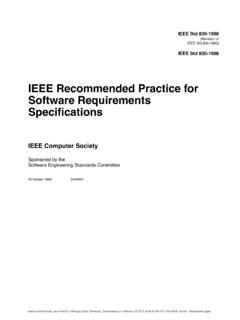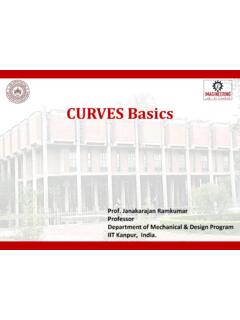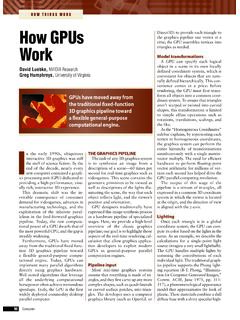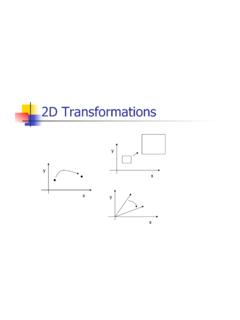Transcription of Classification of Fingerprints - Michigan State University
1 Classification of Fingerprints Sarat C. Dass Department of Statistics & Probability Fingerprint Classification Fingerprint Classification is a coarse level partitioning of a fingerprint database into smaller subsets. Fingerprint Classification reduces the search space of a large database: Determine the class of the query fingerprint. Then, only search templates with the same class as the query. Illustration: Inputs are the fingerprint impressions from 10 fingers of an individual. If size of the database is N and D is the number of classes, 10.
2 Search space without Classification : N. Search space with Classification : (N/D)10. The Henry Classification System Henry (1900) made an extensive study of occurrence of Fingerprints and indexed them into 8 major classes. The 8 classes are shown above. The four different whorl classes can be combined into one class: Whorl (W). The Henry Classification System (cont.). Left-loop (LL) Right-loop (RL) Whorl (W). Plain Arch (PA) Tented Arch (TA). The Henry system with five classes are shown above. The five classes can be reduced to four by combining the PA and TA.
3 Classes to form the Arch (A) class. The natural frequencies of W, L, R and A (A + T) are , , and The Henry Classification System (cont.). The five main classes differ in terms of the global flow patterns of the ridge curves. They also differ in terms of the number and locations of singular points in the fingerprint image. For example, LL exactly one core and one delta; the core is to the left of the delta, RL exactly one core and one delta; the core is to the right of the delta, W two cores and two deltas, PA no singular points, and TA one core and one delta; the delta is approximately directly below the core.
4 Problems with the Henry Classification system: (i) non- uniform Classification proportions, and (ii) experts classify some fingerprint images into different Henry classes. Examples of such Fingerprints are . TA and LL TA and RL TA and PA. Approaches for Fingerprint Classification Approaches based on singular points: Hong and Jain (1999), Karu and Jain (1996). Structure-based approaches such as using the orientation field and geometry of ridges: Cappelli et. al (2002), Chang &. Fan (2002), and Chong et. al (1997). Frequency-based approaches using Fourier spectrum: Jain et.
5 Al (1999). Syntactic or grammar-based: Moayer & Fu (1975,1976). Mathematical models: Silviu & Jain (2002), Dass & Jain (2004). Hybrid methods: Combination of at least two of the above approaches (Chang & Fan (2002) and Chong et. al (1997)). Singular point based approaches Karu and Jain (1996) classifies Fingerprints by detecting singular points in the fingerprint image. 1. The orientation field (flow direction of the ridges at each site in the fingerprint image) is extracted and smoothed. 2. Singular points are detected using the Poincare index.
6 The Poincare index is computed by summing the changes in the angles of flow in a small circle around the test point. It is 0, - , , and 2 for regular, delta, core and double core points, respectively. Core Delta Input image Orientation Field Karu and Jain (1996), cont. The Classification procedure is: Get singular points Determine the number of core-delta pairs, N. 0 1 2. Loop or tented arch ? Arch Left-loop Right-loop Tented Arch Whorl Twin Loop 1. If N=1, consider the straight line joining the core and the delta. If N=2, consider the straight line joining the two cores.
7 Call this line L. 2. For tented arch (whorl), the tangent direction of L is parallel to the local orientation values, but not so for loops (twin loop). Structure based approaches Structure based approaches use global characteristics of the ridges to determine the fingerprint class. Chang & Fan (2002) use ridge distribution models to determine the class of the fingerprint. The 10 basic ridge patterns of Chang &. Fan are given on the left. Chang & Fan (2002). The fingerprint Classification procedure is based on the following steps: 1. For a given fingerprint image, an algorithm for extracting the ridges is developed.
8 This algorithm takes into account (i) ridge bifurcations, and (ii) ridge fragmentations which are not endings. (i) Handling ridge bifurcations (i) Handling ridge fragmentations (a), true ridge endings (b). Chang & Fan (2002), cont. 2. Each extracted ridge is then classified into one of the 10 basic ridge patterns. Some examples of the Classification are: Chang & Fan (2002), cont. 3. The ridge distribution sequence is generated according to the picture below: Each of the 7 classes of the Henry system (except the accidental whorl) has a unique ridge distribution sequence associated to it.
9 Fingerprint images whose ridge distribution sequence cannot be determined are rejected. The accidental whorl class is a subset of the rejected images. Experimental results with the NIST4 database: with rejection rate for 7 classes, and for the 5 classes. Structural based approach - Chong & Ngee (1997). 1. The fingerprint Classification procedure is based on determining the global geometric structure of the extracted ridges using B- splines. 2. The B-splines provide a compact representation of the ridges and contain enough information to determine their geometric structure.
10 3. The main drawback of this method is that it was not tested on a large number of Fingerprints . Frequency based method Jain et. al (1999). 1. Frequency based approached covert the fingerprint image into the frequency space and perform the Classification in that space. 2. In Jain et. al (1999), Gabor filters at 16 different orientation values are applied to different sectors of the fingerprint image. The Gabor coefficients form the feature for Classification . Fingerprint as Oriented Texture (a) Ridges in local region (b) Fourier spectrum of (a).











